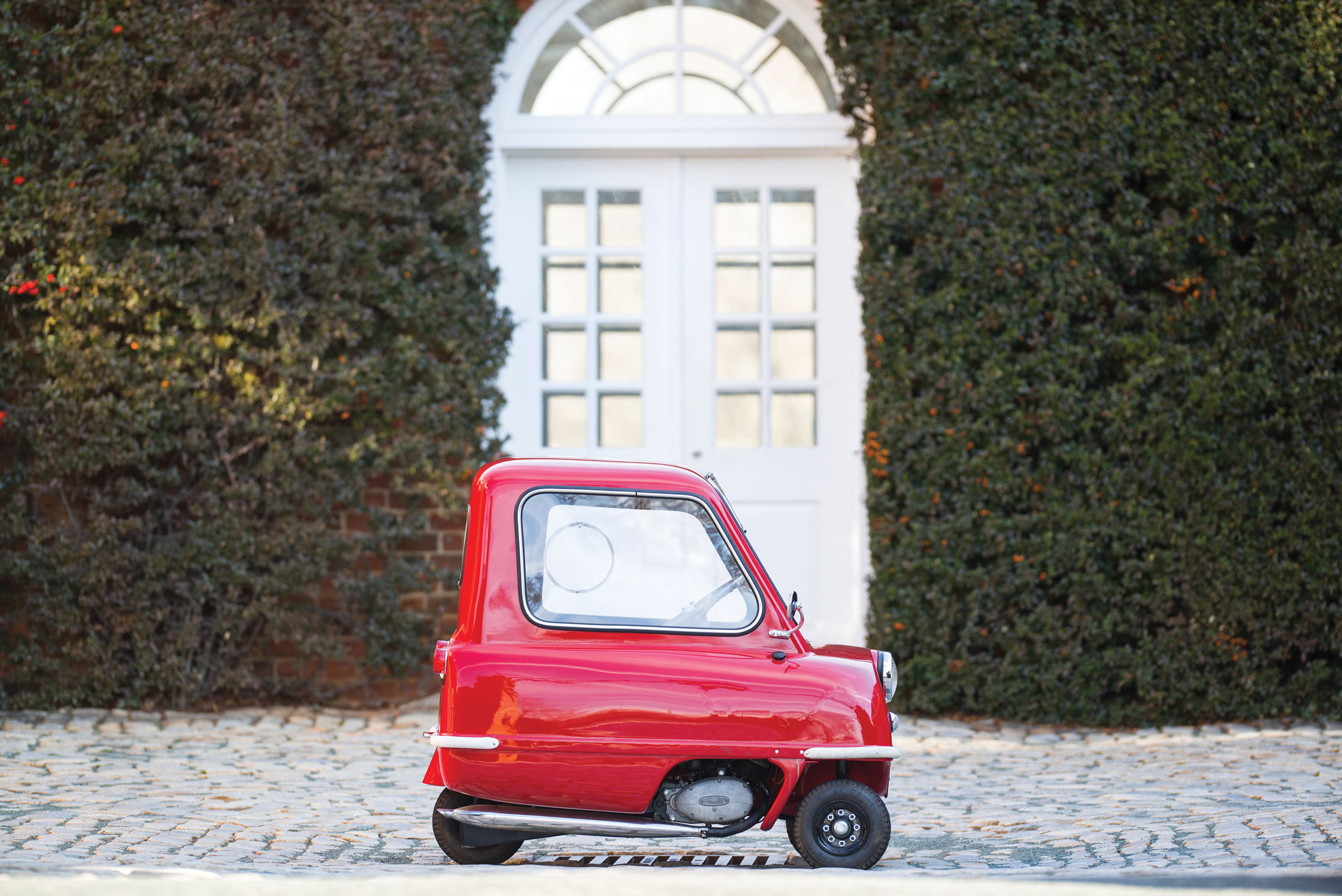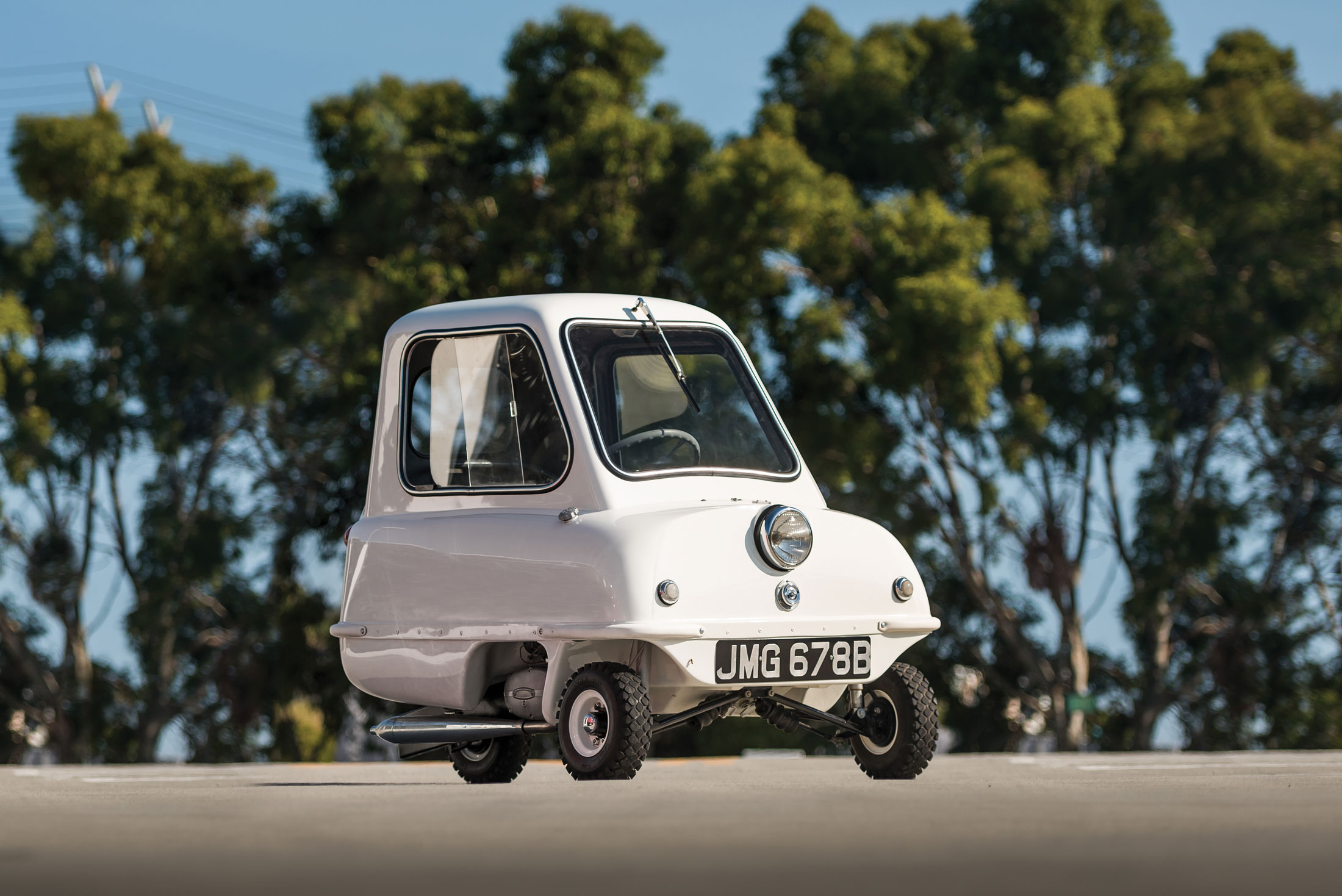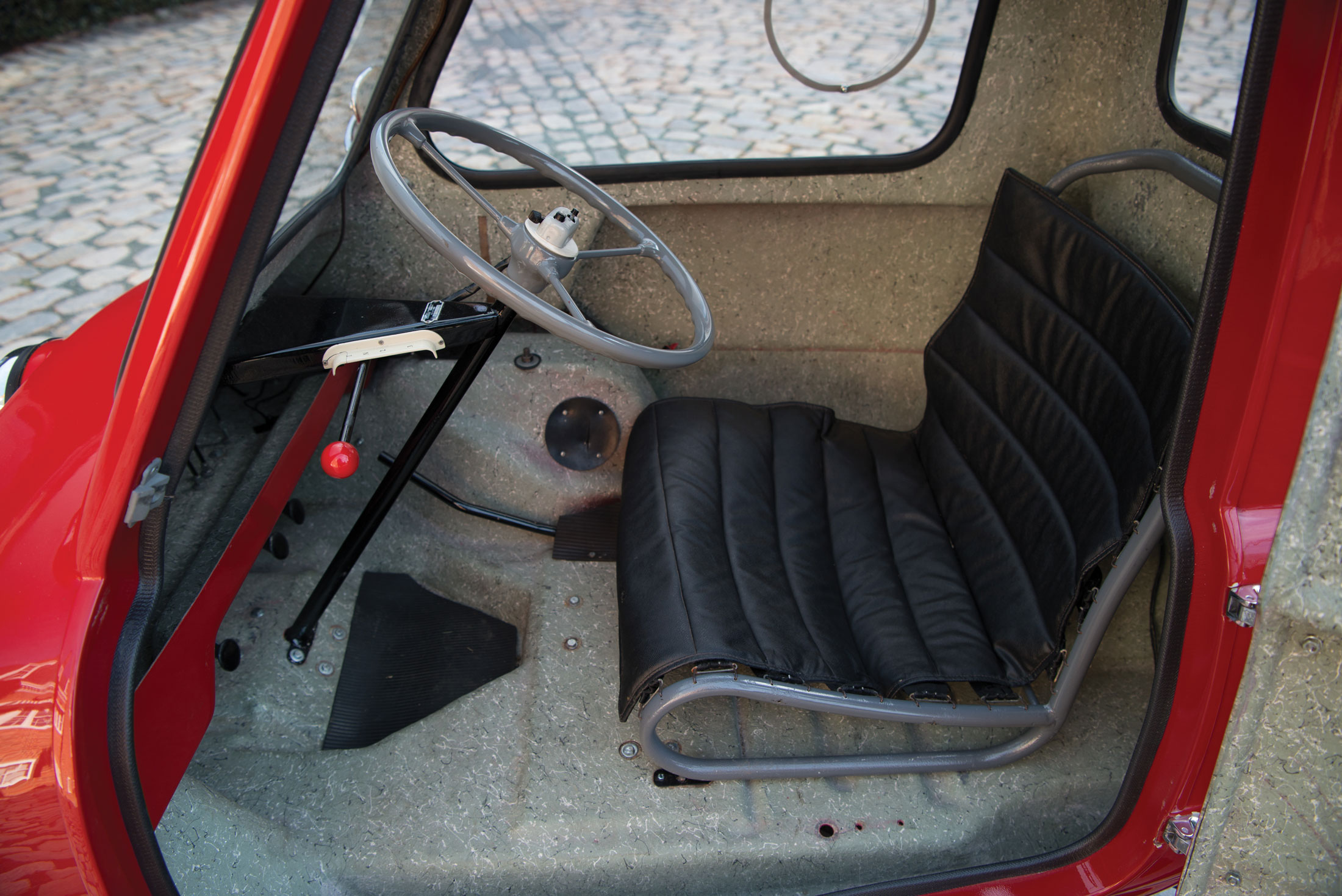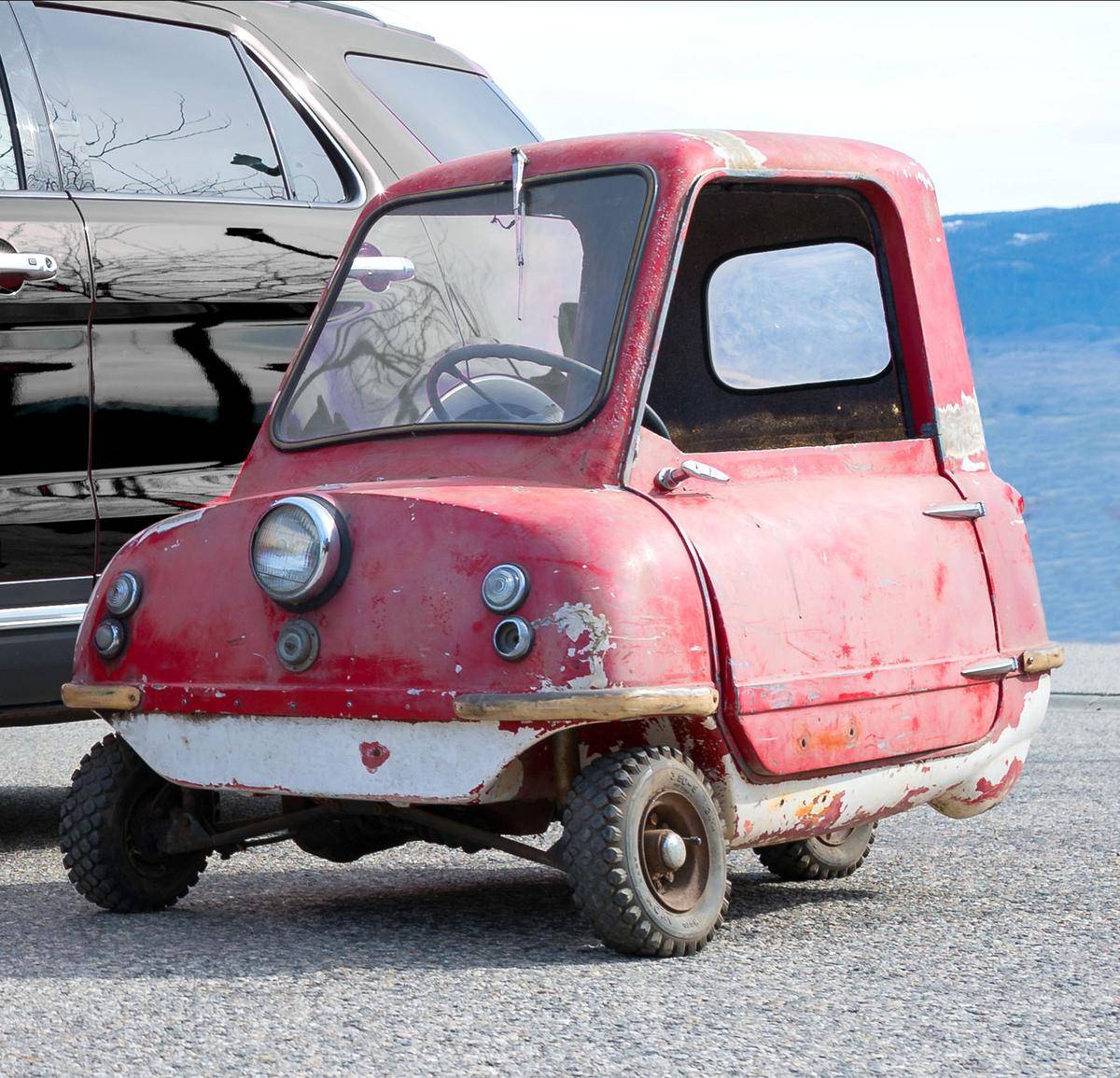Media | Articles
Canada’s Peel P50 was a little car for a big country
Donald “Windy” Erhardt was riding his Harley-Davidson motorcycle to work in Port Coquitlam, British Columbia, when he spotted something tiny and irresistible sitting in the window of a marine supply store. An auto body man by trade, Erhardt grew up in the Canadian prairies with a love for everything on wheels—but he’d never seen anything like this miniscule red car. And what was it doing in a marine shop? He turned his bike around, rumbled into the parking lot, and went inside.
Fifty years later, Don Erhardt Jr. rolls up his garage door to reveal that toy-like red machine, still intact but as worn threadbare and well-loved as the Velveteen Rabbit. The car’s new owner, a Seattle-based car collector and author named Greg Long, is positively gleeful at the sight.
“He looked just like I did when I saw it at seven years old,” Erhardt Jr. says.
Peeling back the curtain

A survivor, a family heirloom, and a Guinness world record-holding curiosity, the little red car is a Peel P50—the smallest production automobile in the world. Built from 1962–65, only 27 are known to exist. They are shockingly valuable: in 2016, a flawlessly restored 1964 example sold for a whopping $176,000. They are also famous, thanks to the antics of Jeremy Clarkson on Top Gear, when he drove a Peel P50 through central London, and then around the interior of the BBC’s administrative offices.
Marketplace
Buy and sell classics with confidence
A typically charismatic oddball of a microcar then, this particular one is a little more special than most. Not only is it the last of the original P50s ever made and a little piece of forgotten Canadian motoring history, it also carries a wealth of family stories, hijinks and high-spirits, motorized freedom, and the occasional ditch-bound mishap.
First, a closer look at the Peel P50 as microcar phenomenon. Established on the Isle of Man in the 1950s, Peel Engineering originally produced fiberglass boat hulls and motorcycle fairings. A tiny island floating in the Irish Sea, the Isle of Man is famous for its motorcycling culture, most notably the dangerous and exhilarating TT races.

The Manx people, as they are known, are a Celtic race with their own unique language and traditions. Somewhere between Northern Irish and Scottish in temperament, the Manx are fond of a thrifty idea, and it was this environment that helped Peel Engineering’s Cyril Cannell come up with the idea for a vehicle based around pure minimalism. Together with co-engineer Henry Kissack, he developed a car that could carry a single person and a shopping bag, and not one whit more.
The P50 is seriously tiny, half the length of a modern British smart fortwo compact car, and is only 1000 mm (40 inches) wide and 1200 mm (47 inches) tall. Without anything stored in the fiberglass body, it weighs just 105 kilos (230 pounds). The P50 has three wheels, one door, one headlight, one windshield wiper, and a single-cylinder DKW 49-cc scooter engine producing 4.2 horsepower. The three-speed manual column-shift transmission does not offer a reverse gear; instead, there’s a handle on the rear for a driver to lift and turn the car around.
Launched in 1962 at the Earls Court motorcycle show in London, the P50 was priced at a reasonable £199, approximately $1250 (U.S.) today. Regrettably, it was not a success. The success of the BMC Mini had already begun an end to the age of the post-WWII bubblecar boom, and people simply thought the P50 was too small to be properly useful. Peel Engineering took one up in an elevator and drove it around the observation deck at Blackpool Tower as a publicity stunt, but the public was unmoved. P50 production stopped in 1965 with fewer than 50 cars produced, and Peel itself went out of business in the mid-1970s.
Survivor

Which brings us to that marine supply store on the old Barnet highway in 1968. The story the shop’s owner told Windy Erhardt was that the P50 had been traded in by a Russian freighter in exchange for some refrigeration equipment. Windy, who had acquired his nickname in grade school for his gift of the gab, soon talked the price down to $100. He returned later in the afternoon, loaded the Peel onto a trailer, and took it home.
Whether or not the Russian freighter yarn is true is up for some debate, because where would a crew of Russians get their hands on a Peel P50? However, what is known is that this particular P50’s chassis code, E111, makes it one of the last P50s, if not indeed the last one ever made. It’s one of three cars—two P50s and one two-seat Trident, all in red—that were exported to British Columbia as part of Peel’s only overseas dealer effort. The cars were brought in by Jim Birrell of Richmond, British Columbia, in 1965.
British Columbia is a third bigger than Texas, so what was the smallest car in the world doing here? Perhaps the thought was that the P50 would be an ideal fit for the sleepy colonial capital of Victoria, where the weather is mild, and residents still don’t drive very far. Classified as a motorcycle by the provincial government, the P50 was cheap to insure. Birrell drove the car to the Victoria legislature, where it received official governmental endorsement. Both imported P50s were built to a slightly unique Canadian-spec, namely, the installation of a tube to harvest heat from the DKW engine to warm the cabin.
Like a regular car, but way, way smaller

The Erhardt family wasn’t aware of how rare this P50 was, only that it had all the functions of a normal car, in postage-stamp size. Windy had grown up in the Canadian prairies in the 1930s, and cars had been his escape from the everyday, and his first love. “My dad lived out American Graffiti in small-town Saskatchewan,” is how Don Erhardt puts it. The Peel might have been comical, but the entire family loved it nonetheless.
Seven-year-old Don Erhardt took an immediate shine to the car and learned to drive it on his family’s acreage. One day, after both his father and mother drove off to work in their separate cars, he had an idea.
“I thought, ‘If they’re going to drive, then I’m going to do the same thing,’” he says now. So he hopped into the P50 and headed out on the five-mile drive to his grade school. Next thing you know, there’s a little red microcar tearing around the school’s soccer field, honking away happily, trailed by a pack of screaming kids. The fun didn’t last too long.

“Dad went and got the trailer to bring the Peel back, and I was allowed to stay home from school that day,” Don says. “I guess the teachers weren’t too happy about it.”
Another time, Don was testing out the P50’s 60-km/h (38-mph) top speed, when he noticed how unstable the car became at speed. Specifically, he noted the instability when the Peel speared off the road and into a broad culvert, where it became firmly wedged on one side, with the single door completely stuck. After the best part of an hour, a friendly neighbor came along and fished out young Erhardt. Afterwards, the roof was cut off the P50, half as a safety measure, half to make it more comfortable to drive in the summer.
Somehow, the P50 weathered all this abuse and was still running under its own power as recently as 2002. Windy Erhardt, who by then lived in Cochrane, Alberta, got the Peel running, reattached the roof, and entered it in the local parade with his grandkids, where they diced it up with the Shiners and their little cars. It was just the type of enthusiastic escapade the community expected from Windy. He was such a well-known character that a postcard from a fellow motorcycle fan in the UK reached him easily, despite being addressed simply: “Windy, A&W restaurant, Cochrane, AB, Canada.”
Finding a new home

The dream was always to restore the P50, to bring it back to its former glory. However, Windy’s health wasn’t up to the task, and time and distance conspired to slow the project up. When Donald Erhardt Sr. passed away, the family made the decision to sell the car, if they could find a buyer who would honour the spirit of their Peel.
Enter Greg Long, who has exactly the same sort of wide-eyed optimism that Windy carried his whole life. The owner of a rare 1966 Citroën DS21 Chapron Decapotable and a 1967 Porsche 911S Targa, Long uses both in long distance classic car rallying, and describes himself as “Mr. Preservation Class.”
Despite its rarity, restoring the Peel isn’t a gargantuan task. The company was reborn in 2011, following an appearance on the UK version of Dragon’s Den. It’s currently possible to buy a brand-new P50 or Trident with one of several engine options, including electric-powered units. Parts that will fit the original version will take a bit of sleuthing, but they exist.
Once the car is restored, the Erhardts hope to travel down to Long in Seattle to see their little car run under its own power again, brought back to its former glory, and out on the road again. You have to think that’s just the way Windy would have wanted it.



